Introduction:
In the realm of educational pedagogy, project-based learning (PBL) has emerged as a dynamic and student-centered approach that transcends traditional classroom boundaries. Rooted in the philosophy of learning by doing, PBL emphasizes real-world applications, problem-solving, and collaborative engagement. In this article, we will delve into the significance of project-based learning and how it enhances educational experiences by bringing theory to life through hands-on projects.
- Defining Project-Based Learning: A Hands-On Approach to Education
Project-based learning is an instructional methodology that immerses students in real-world, problem-solving experiences. Instead of relying solely on traditional lectures and assessments, PBL encourages students to explore, investigate, and apply knowledge through the completion of projects. These projects are typically multifaceted, requiring critical thinking, collaboration, and the application of skills in a meaningful context.
- Real-World Applications: Bridging the Gap Between Theory and Practice
One of the core tenets of project-based learning is its emphasis on real-world applications. By engaging students in projects that mirror authentic scenarios, educators bridge the gap between theoretical knowledge and practical application. Whether it’s designing a sustainable community project or conducting scientific experiments, students gain a deeper understanding of concepts as they see the direct relevance to their lives and the world around them.
- Inquiry and Critical Thinking: Nurturing Curiosity and Analytical Skills
Project-based learning places a strong emphasis on inquiry and critical thinking. Students are encouraged to ask questions, analyze information, and explore solutions to real-world problems. This process not only fosters a sense of curiosity but also hones critical thinking skills, equipping students with the ability to evaluate information, make informed decisions, and solve complex problems.
- Collaborative Engagement: Teamwork and Communication Skills
Collaboration is a cornerstone of project-based learning. Students work collaboratively on projects, sharing ideas, dividing tasks, and collectively working towards a common goal. This collaborative engagement not only enhances teamwork and communication skills but also exposes students to diverse perspectives, mirroring the collaborative dynamics often seen in professional settings.
- Ownership of Learning: Fostering Intrinsic Motivation
In project-based learning, students take ownership of their learning journey. As they delve into projects that align with their interests and passions, they become more intrinsically motivated. This sense of ownership fuels a desire to delve deeper into topics, explore related areas, and go beyond the basic requirements, fostering a lifelong love of learning.
- Authentic Assessment: Beyond Traditional Testing
Assessment in project-based learning goes beyond traditional testing methods. Instead of relying solely on exams, educators assess students through the completion of projects. This authentic assessment provides a comprehensive view of a student’s understanding, problem-solving abilities, and collaboration skills. It also allows for the evaluation of skills such as creativity, adaptability, and perseverance.
- Preparation for the Future: 21st Century Skills
Project-based learning is a powerful tool for preparing students for the demands of the 21st century. The skills cultivated through PBL—such as critical thinking, collaboration, communication, and adaptability—are highly valued in the professional world. By engaging in real-world projects, students develop a skill set that goes beyond academic knowledge, positioning them for success in the evolving landscape of the workforce.
- Multidisciplinary Integration: Connecting Subjects for Holistic Understanding
Project-based learning naturally lends itself to the integration of multiple disciplines. Projects often require the application of knowledge from various subjects, fostering a holistic understanding of concepts. This multidisciplinary approach mirrors the interconnected nature of real-world challenges and provides students with a broader perspective on how different fields of study intersect and complement each other.
Conclusion:
Project-based learning stands as a beacon in educational pedagogy, offering a transformative approach that brings education to life through real-world applications and problem-solving. By immersing students in hands-on projects, educators cultivate critical thinking, collaboration, and a passion for learning. Project-based learning not only enhances academic understanding but also prepares students for the challenges and opportunities of the future. As we continue to innovate in education, project-based learning emerges as a dynamic and effective pedagogical approach, promising a future where students are not just recipients of knowledge but active contributors to their own learning journey and to the solutions of real-world problems.
